

WiMAX - 802.16. WiMAX (Worldwide Interoperability for Microwave Access) is a wireless communications standard designed to provide 30 to 40 megabit-per-second data rates,[1] with the 2011 update providing up to 1 Gbit/s[1] for fixed stations.
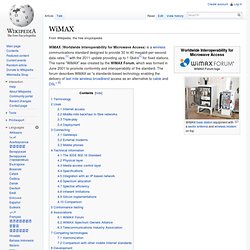
The name "WiMAX" was created by the WiMAX Forum, which was formed in June 2001 to promote conformity and interoperability of the standard. The forum describes WiMAX as "a standards-based technology enabling the delivery of last mile wireless broadband access as an alternative to cable and DSL".[2] Terminology[edit] WiMAX refers to interoperable implementations of the IEEE 802.16 family of wireless-networks standards ratified by the WiMAX Forum. (Similarly, Wi-Fi, refers to interoperable implementations of the IEEE 802.11 Wireless LAN standards certified by the Wi-Fi Alliance.) The original IEEE 802.16 standard (now called "Fixed WiMAX") was published in 2001. Uses[edit] The bandwidth and range of WiMAX make it suitable for the following potential applications: Backhaul (telecommunications)
In a hierarchical telecommunications network the backhaul portion of the network comprises the intermediate links between the core network, or backbone network and the small subnetworks at the "edge" of the entire hierarchical network.
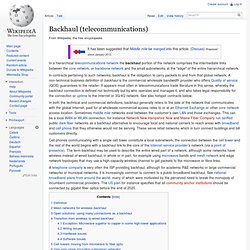
In contracts pertaining to such networks, backhaul is the obligation to carry packets to and from that global network. A non-technical business definition of backhaul is the commercial wholesale bandwidth provider who offers Quality of service (QOS) guarantees to the retailer. It appears most often in telecommunications trade literature in this sense, whereby the backhaul connection is defined not technically but by who operates and manages it, and who takes legal responsibility for the connection or uptime to the Internet or 3G/4G network. See also hotspot contracts below. Other examples include: Horizon Quantum - DragonWave. Delivering from 2 to 4 Gbps per link, Horizon Quantum represents the next generation in packet microwave technology and sets a new benchmark for performance.

With dual-channel capability, this split-mount system is a step change in spectral efficiency, capacity, nodal intelligence, and operational simplicity; all while occupying only half a rack unit and consuming the lowest power per bit of any solution today. In addition, the Horizon Quantum’s integrated switching means that it can provide aggregation and restoration in a single unit.
With this level of performance – in a packet microwave system that is remarkably simple to install and operate – operators can now avoid the high cost and long delays associated with fiber deployments, yet achieve the capacity and reliability they require for all of their future applications and services. Solution Highlights: Proxim - WISP Backhal Products. Purchase WISP Equipment. IEEE 802.11a/b/g/n Digital WiFi Standard. IEEE 802.11n-2009, commonly shortened to 802.11n, is a wireless networking standard that uses multiple antennas to increase data rates.
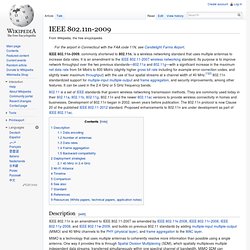
It is an amendment to the IEEE 802.11-2007 wireless networking standard. Its purpose is to improve network throughput over the two previous standards—802.11a and 802.11g—with a significant increase in the maximum net data rate from 54 Mbit/s to 600 Mbit/s (slightly higher gross bit rate including for example error-correction codes, and slightly lower maximum throughput) with the use of four spatial streams at a channel width of 40 MHz.[1][2] 802.11n standardized support for multiple-input multiple-output and frame aggregation, and security improvements, among other features. It can be used in the 2.4 GHz or 5 GHz frequency bands. Wireless Broadband, Point To Point, Multipoint Wireless & Networking Solutions. Ruckus Wireless. Ruckus Wirless 802.11n article. Ruckus Wireless is now offering a comprehensive 802.11n system for wireless carriers.

Cisco Aironet.
Long Range Wi-Fi, WiMAX, LTE and broadband news. Long-range Wi-Fi (802.11) Long-range Wi-Fi is used for low-cost, unregulated point-to-point computer network connections, as an alternative to other fixed wireless, cellular networks or satellite Internet access.
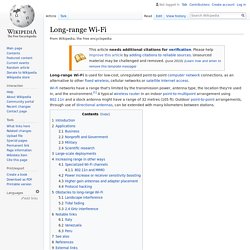
Introduction[edit] Since the development of the IEEE 802.11 radio standard (marketed under the Wi-Fi brand name), the technology has become markedly less expensive and achieved higher bit rates. Line-of-sight propagation. Line-of-sight propagation refers to electro-magnetic radiation or acoustic wave propagation.
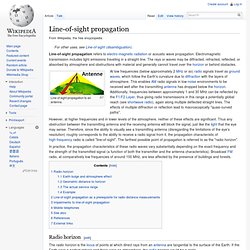
Electromagnetic transmission includes light emissions traveling in a straight line. The rays or waves may be diffracted, refracted, reflected, or absorbed by atmosphere and obstructions with material and generally cannot travel over the horizon or behind obstacles. Line of sight propagation to an antenna However, at higher frequencies and in lower levels of the atmosphere, neither of these effects are significant. Thus any obstruction between the transmitting antenna and the receiving antenna will block the signal, just like the light that the eye may sense. AlphiMAX Home - Solutions For A Wirless World. Link Possibility Calculator.
How To: Wireless Video Surveilance (municiple perk) Homebrew antenna shootout. The Shootout My plan was to get relative performance measurements for various designs (including mine) of homebrew antennas for 802.11b (WiFi) wireless networks.
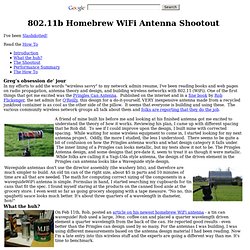
To do this, I setup a wireless link and changed only the antenna- recording each antennas' performance under identical conditions. I didn't compare them to a commercial directional antenna as my only one has a male connector and I don't have the right cable to hook it up yet. The contestants were (click on each for design specifications). The Performance Summary The results surprised me! In our test, the Flickenger Pringles can did a little better than my modified Pringles design. Of the waveguides, the Nalley's "Big Chunk" took top marks. 304km with RouterOS + XR5 + handmade antenna. Homebrew WISP ( Wireless ISP) Materials Needed:Plastic Transhcan - used as enclosureAccess PointHomebrew POE Injector and AntennaPower Supply Regulator a.
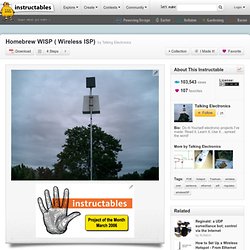
Fitting the Access Point and Supply Regulator Using a plywood, cut the desired size so that it will fit inside the trashcan. Directory. Wireless Network Design , Engineering and Mapping Services. WISP%20National%20Map. Spectrum Dashboard - Reboot.FCC.gov. Home About Reboot Events Initiatives Reform FCC Leadership Blog FCC.gov/data Exploring America's Spectrum The Spectrum Dashboard allows new ways for citizens to search spectrum in the United States. Browse Spectrum Bands Learn more about the current spectrum distribution by browsing a chart of the spectrum bands, or by searching specific frequency ranges. API Resources for Developers Browse Using a Map Use an interactive map to find information on licensees in a particular county or state.
Search by Name Search by "common name" (AT&T, Verizon, etc) to learn who holds spectrum licenses around the country. Advanced Search Search by name, radio service, frequency range, channel block, or call sign to learn who holds spectrum licenses around the country. FCC License View A single portal for information on the management of FCC licenses. Spectrum Dashboard Reports 1-click access to commonly requested data and popular reports. High Speed Internet - Nebraska, Wyoming.